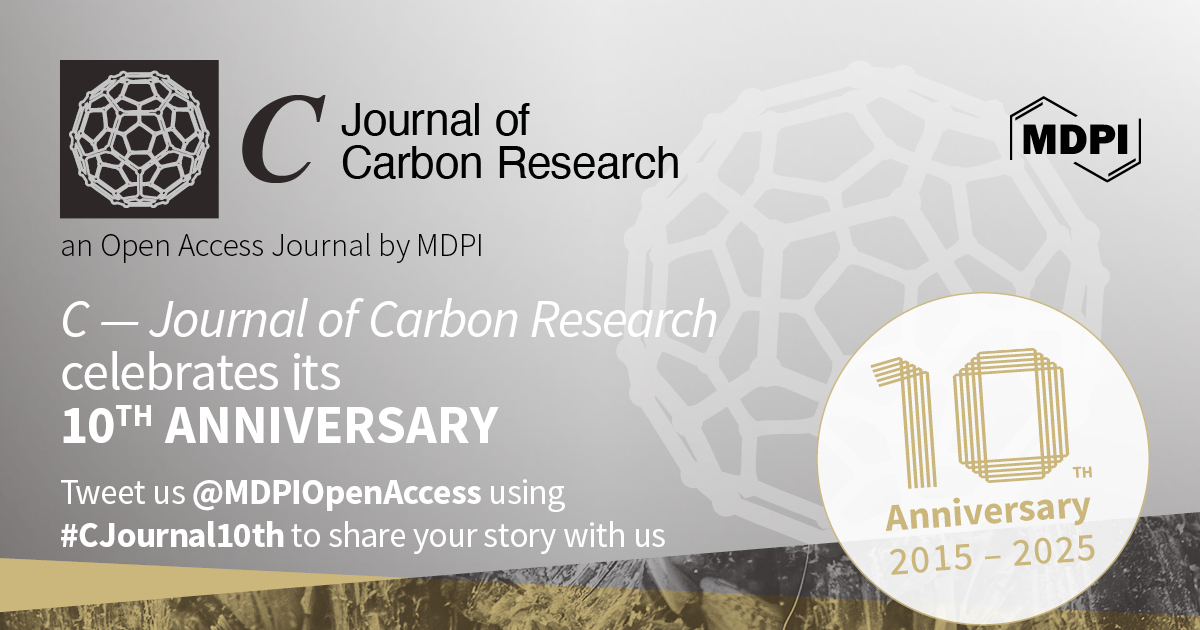10th Anniversary of C — Journal of Carbon Research
A special issue of C (ISSN 2311-5629).
Deadline for manuscript submissions: 31 January 2026 | Viewed by 11058

Special Issue Editor
Interests: electrochemistry; additive manufacturing; 2D material electrochemistry; sensor design and development; screen-printing and related sensor fabrication; electron transfer; sono-electrochemistry; nanoparticles
Special Issues, Collections and Topics in MDPI journals
Special Issue Information
Dear Colleagues,
Congratulations on the 10th Anniversary of C — Journal of Carbon Research. As Editor-in-Chief, it is inspiring to see how far we have come in establishing the journal as a leading platform for advancing carbon research. Our inclusion in ESCI, Scopus, and other prestigious databases reflects the quality and impact of the papers published.
This achievement would not have been possible without the dedication of our editorial team, editors, reviewers, and, most importantly, the authors who have contributed to the journal’s success. Their commitment to excellence has been instrumental in shaping the journal’s reputation and influence.
To mark this milestone, we are proud to present a 10th Anniversary Special Issue, a commemorative collection that showcases groundbreaking research from highly cited scholars and explores impactful topics in carbon science. By featuring leading experts and cutting-edge studies, this issue will highlight the most significant advancements in the field, reinforcing the journal’s role in driving scientific progress. We extend our gratitude to all who have been part of this journey and look forward to continuing to push the boundaries of carbon research in the years ahead.
Prof. Dr. Craig E. Banks
Guest Editor
Manuscript Submission Information
Manuscripts should be submitted online at www.mdpi.com by registering and logging in to this website. Once you are registered, click here to go to the submission form. Manuscripts can be submitted until the deadline. All submissions that pass pre-check are peer-reviewed. Accepted papers will be published continuously in the journal (as soon as accepted) and will be listed together on the special issue website. Research articles, review articles as well as short communications are invited. For planned papers, a title and short abstract (about 250 words) can be sent to the Editorial Office for assessment.
Submitted manuscripts should not have been published previously, nor be under consideration for publication elsewhere (except conference proceedings papers). All manuscripts are thoroughly refereed through a single-blind peer-review process. A guide for authors and other relevant information for submission of manuscripts is available on the Instructions for Authors page. C is an international peer-reviewed open access quarterly journal published by MDPI.
Please visit the Instructions for Authors page before submitting a manuscript. The Article Processing Charge (APC) for publication in this open access journal is 1600 CHF (Swiss Francs). Submitted papers should be well formatted and use good English. Authors may use MDPI's English editing service prior to publication or during author revisions.
Keywords
- carbon science
- scientific progress
- groundbreaking research
Benefits of Publishing in a Special Issue
- Ease of navigation: Grouping papers by topic helps scholars navigate broad scope journals more efficiently.
- Greater discoverability: Special Issues support the reach and impact of scientific research. Articles in Special Issues are more discoverable and cited more frequently.
- Expansion of research network: Special Issues facilitate connections among authors, fostering scientific collaborations.
- External promotion: Articles in Special Issues are often promoted through the journal's social media, increasing their visibility.
- Reprint: MDPI Books provides the opportunity to republish successful Special Issues in book format, both online and in print.
Further information on MDPI's Special Issue policies can be found here.





